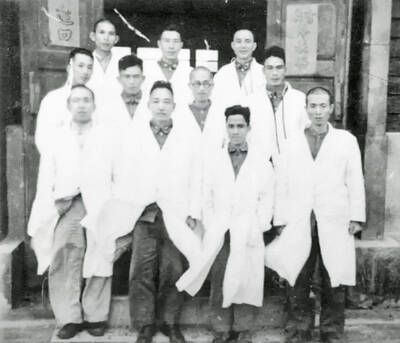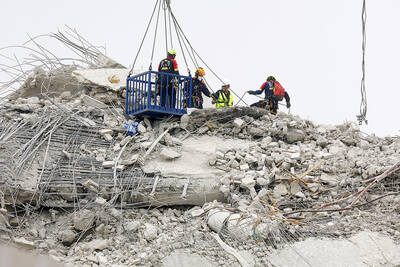Hello Kitty Sweets on Da-an Road is a kawaii mecca for the cult of the bobble-headed cartoon cat. A gigantic oval portrait of Hello Kitty mounted on the restaurant’s roof gives it a temple-like aura. The menu at Hello Kitty Sweets is not particularly memorable, as perhaps befits an establishment named after a cat with no mouth, but that might be beside the point. The main purpose of Hello Kitty Sweets seems to be providing a super girly, lace-festooned and very pink backdrop for photographs. It certainly succeeds on that front — on a recent Saturday, one group of happy young women even brought a giant Hello Kitty stuffed toy to pose with.
Not surprisingly, the dessert sets are the most photogenic and tasty part of Hello Kitty Sweets’ menu. Most of them are decorated with Hello Kitty-shaped chocolate pieces, Hello Kitty drawn on with icing, or green tea or chocolate-flavored powder sprinkled through a Hello Kitty stencil directly onto the plate.
Chocolate lovers will have a chocogasm over the Cointreau black chocolate tart (君度黑巧克力塔, NT$360), which is a pastry crust filled with chocolate truffles and topped with yet more chocolate truffles. If this tart were a Sanrio character, it would be Chococat, a little black kitty with big round eyes. More delicate in flavor is the “mad for strawberries” cake (草莓狂想, NT$340), layers of fluffy white cake interspersed with whipped cream and strawberries. Sweet, pretty and light, the “mad for strawberries” is the My Melody of the menu and is much less likely to put you in a sugar coma than the chocolate tart. In case you’re wondering, this character is a red-hooded white rabbit. One dessert that doesn’t deserve a Sanrio mascot is the boring almond tart with red wine poached pear (杏仁紅酒梨塔, NT$360). The almond tart had a pleasant buttery sweet flavor and texture that resembled shortbread, but the poached slices of pear on top were limp, clammy and flavorless.
Hello Kitty Sweets’ entrees are much less adorable. We ordered a steak topped with goose liver pate (嫩肩牛排佐鵝肝醬, NT$580). The meat was appealingly tender but curiously bland, leaving the very rich, somewhat salty pate to compensate for the lack of flavor. The pate and the bed of mushrooms sauteed in a spicy tomato sauce that the steak was served on both outshone the beef. My companion was also displeased with the candy-like raspberry sauce that covered one third of his plate, which, judging from its near identical appearance, seemed to have been made from the same mix as my glass of raspberry juice (綜合莓果茶, NT$180).
I had better luck with my smoked salmon Caesar salad (鮭魚凱薩沙拉, NT$350). The slices of fish were curled into little rosettes and sprinkled with chopped onions and tasty capers. The large bed of iceberg lettuce was tedious to work through, but the creamy, tangy, Parmesan-rich Caesar sauce made up for it (even though it wasn’t served in a Hello Kitty shaped cup).

A vaccine to fight dementia? It turns out there may already be one — shots that prevent painful shingles also appear to protect aging brains. A new study found shingles vaccination cut older adults’ risk of developing dementia over the next seven years by 20 percent. The research, published Wednesday in the journal Nature, is part of growing understanding about how many factors influence brain health as we age — and what we can do about it. “It’s a very robust finding,” said lead researcher Pascal Geldsetzer of Stanford University. And “women seem to benefit more,” important as they’re at higher risk of

March 31 to April 6 On May 13, 1950, National Taiwan University Hospital otolaryngologist Su You-peng (蘇友鵬) was summoned to the director’s office. He thought someone had complained about him practicing the violin at night, but when he entered the room, he knew something was terribly wrong. He saw several burly men who appeared to be government secret agents, and three other resident doctors: internist Hsu Chiang (許強), dermatologist Hu Pao-chen (胡寶珍) and ophthalmologist Hu Hsin-lin (胡鑫麟). They were handcuffed, herded onto two jeeps and taken to the Secrecy Bureau (保密局) for questioning. Su was still in his doctor’s robes at

Last week the Democratic Progressive Party (DPP) said that the budget cuts voted for by the China-aligned parties in the legislature, are intended to force the DPP to hike electricity rates. The public would then blame it for the rate hike. It’s fairly clear that the first part of that is correct. Slashing the budget of state-run Taiwan Power Co (Taipower, 台電) is a move intended to cause discontent with the DPP when electricity rates go up. Taipower’s debt, NT$422.9 billion (US$12.78 billion), is one of the numerous permanent crises created by the nation’s construction-industrial state and the developmentalist mentality it

Experts say that the devastating earthquake in Myanmar on Friday was likely the strongest to hit the country in decades, with disaster modeling suggesting thousands could be dead. Automatic assessments from the US Geological Survey (USGS) said the shallow 7.7-magnitude quake northwest of the central Myanmar city of Sagaing triggered a red alert for shaking-related fatalities and economic losses. “High casualties and extensive damage are probable and the disaster is likely widespread,” it said, locating the epicentre near the central Myanmar city of Mandalay, home to more than a million people. Myanmar’s ruling junta said on Saturday morning that the number killed had